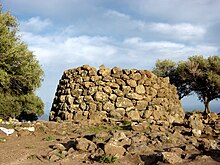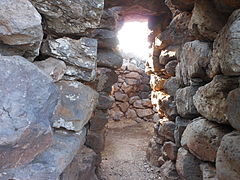Nuraghe Mannu
The Nuraghe Mannu at Cala Gonone is a 3500 year old Bronze Age stone tower not far from Dorgali on the east coast of Sardinia . From the tower, which is located on a small plateau almost 200 m above sea level, one has a wide view over the sea to the small pebble bay Fuili and into the Codula Fuili gorge. There is archaeological evidence that the Bay of Fuili was used as a natural harbor by the Sardinian indigenous people. Nuraghi are prehistoric and early historical towers of the Bonnanaro culture (2200–1600 BC) and the subsequent nuraghi culture (around 1600–400 BC) in Sardinia, which is inextricably linked with it .
description
The first references to the Nuraghe Mannu came from Antonio Taramelli , who explored the complex , which is surrounded by a nuragic settlement in 1927. The hut village built from square basalt stones is dominated by the nuraghe, which despite its name "mannu" (means "large" in Sardinian) is a tholosnuraghe of rather modest dimensions, which was built from large basalt blocks built in irregular rows. The entrance in the southeast is covered by an irregular lintel , above which rows of blocks have been preserved up to heights of between 4.3 and 3.5 m. Above that lies the rest of a small window opening. The corridor, which is 3.7 m long and 1.2 m wide, is covered by slabs of rock and leads to an eccentrically positioned chamber of equal thickness (3.6 by 4.6 m) with two large kidney-shaped niches that do not reach the floor. In the corridor there is access to the remains of the stairs to the higher, not preserved level. Around the nuraghe, which is 12.8 m in diameter, lies the several hectare nuragic settlement, which was freed from vegetation during the excavation.
In 1933 Antonio Taramelli (1868–1939) wrote a report on his observations. He pointed out the presence of stone blocks that belong to Roman era structures. The discovery of basalt blocks with geometric patterns gave an indication of the presence of a place of worship that could be compared to decorative elements and construction techniques found in Bonorva , Nuragus , Sardara and Serri .
- Nuraghe Mannu
Since 1994, the Nuraghe Mannu has been the subject of eight excavation campaigns with around 700 helpers. The excavations of the village and the nuraghe revealed information about the first construction phase of the village in the Middle Bronze Age (1500 BC). The amount of finds, however, came from the late Bronze Age (1200-1000 BC). In addition to ceramic materials, tools and objects of daily use such as ovens, pestles, various grinding stones were found that document the cultivation of grain. Near the excavations, a building was investigated that had been built over the remains of the nuragic settlement. A trapezoidal stone with three holes on the short side (which were intended for baityloi ) is typical of the younger type of the so-called giant tombs . Fragments of roof tiles, dishes and vases from the 4th century as well as amber , bronze needles and broken glass were found in the Roman building . Among the ceramics were large pieces of pithoi that were used as containers for wine, oil, etc.
See also
literature
- Antonio Taramelli: Foglio 208. Dorgali in Edizione della Carta Archeologica d'Italia, Firenze, Istituto Geografico Militare, 1929;
- Antonio Taramelli: in Notes degli Scavi , IX, 1933;
- Alberto Moravetti: Serra Orrios ei monumenti archeologici di Dorgali , collana «Sardegna archeologica. Guide e Itinerari », 26, Sassari, Carlo Delfino, 1998.
Web links
Coordinates: 40 ° 15 ′ 33.4 " N , 9 ° 37 ′ 13.1" E





